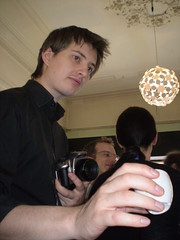 22 august there was this fascinating article in 'The News & Observer'.
22 august there was this fascinating article in 'The News & Observer'.At 7:30 a.m. on Fridays, about a dozen men -- mainly engineers and scientists by profession, some dressed in T-shirts and jeans, others in RTP-appropriate dress-shirts and slacks -- gather at Counter Culture Coffee. The Durham coffee roaster hosts these weekly gatherings at its barista training center so these men can play with a special edition La Marzocco FB-80, a gleaming, chrome and blue machine that can brew three espresso shots at once and costs $14,000.
On a recent Friday, Dan Kehn, the espresso-obsessed Cary man behind www.home-barista.com, and Kevin Krautwald, a telecommunications engineer at Tekelec, are manning the La Marzocco FB-80. The two make shot after shot, while the others evaluate. Akin to a wine tasting, they inspect. They sniff. They sip. They swirl. They repeat.
Holding a small white cup and judging his handiwork, Kehn says, "That is pretty. I beat you there, buddy."
"Mine tastes better," Krautwald retorts.
The difference between the two shots is discernible only to these men. They object to being called coffee snobs and prefer "espresso illuminati."
Among their ranks: Kehn, who gets paid to review espresso equipment and describes the difference between coffee made with high-end versus low-end machines as comparable to the difference between H…agen-Dazs and Sealtest ice cream; Lino Verna, a mechanical design consultant from Creedmoor who modifies espresso filter handles as a small part of his company's business; Krautwald, who occasionally informs coffee shop baristas that he is a certified judge with the Speciality Coffee Association of America and offers them pointers ("Do you flash your badge?" Verna quips); and Mike Walsh, who showed this reporter how to roast coffee beans at home using a secondhand $2 popcorn popper, an empty green bean can and a screwdriver.
These men are not alone in their obsession. With the rise of Starbucks and an expanding awareness that there is more to coffee than Folgers brewed in a Mr. Coffee, more Americans are developing a refined palate for coffee, espresso and the like. In 2007, for the first time in two decades, the percentage of people who drank coffee every day -- 57 percent -- surpassed the percentage of people who drank soft drinks daily, 51 percent, according to the National Coffee Association. By another measure, there were 1,650 coffee shops in the United States in 1991. Last year, there were 23,900.
Seeking perfection
For the espresso illuminati, perfection requires specific instructions.
An espresso should be brewed within 30 seconds after grinding the beans. (Of course, those beans were roasted within the last two weeks.) You then measure the grounds, evenly distribute them in the filter basket, level them, tamp them and hope that the water temperature, pressure and volume will extract the right balance of flavors. A good shot will have a crema with caramel-colored foam and dark flecks resembling a sprinkling of cinnamon. The crema will be thick and have staying power. The espresso will taste buttery and possess a sweet-bitter balance, akin to dark chocolate.
Because so many things can go wrong, the ideal is elusive.
"In espresso preparation, if you are off the mark by a very little bit, you rapidly miss the mark," explains Bob Barraza, a retired chemist in Apex who coined the term "espresso illuminati."
In pursuit of perfection, these men bring their science minds to their favorite beverage.
"Coffee is at its best when you weigh it, you grind it precisely -- that appeals to these guys," said Peter Giuliano, Counter Culture Coffee's co-owner and director of coffee. "When you approach it in that way, that's when you unlock its potential. There's a natural symbiosis."
Talking smack
Before brewing began on that same Friday, Kehn announced that they would be conducting an experiment: comparing the Mazzer Super Jolly Espresso Grinder, priced at $699, versus the Mazzer Kony Espresso Grinder, costing about $1,400. Each shot would use 18 grams of Counter Culture Coffee's Aficionado espresso that had rested for three days. They would conduct a blind side-by-side comparison to determine "which one is really worth the extra money for a home barista." However, no winner was chosen that morning.
The orderly taste test evolves into caffeine-fueled play. The baristas are taunting each other's shot-making skills. Kehn jokingly asks if Counter Culture Coffee will sponsor his attendance at the World Barista Championship in Tokyo. The men debate what to serve this observer: a macchiato.
Watching the scene, Mark Overbay, Counter Culture Coffee's marketing manager, observes, "The technical stuff is out the window. Now we're just making drinks and talking smack."
















